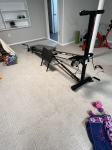Save Ritzer Field
I'm all in for turf! "I just want to say one word to you. One word. Plastics."
DanDietrich said:
This debate is really tiring. The only thing you all seem to have in common is that none of you have kids in the schools now. Maybe there is a strong case for having fields that other teams are willing to play on. Maybe athletics are an important part of high school. My kid plays hockey, and ice rinks are not very green, but I think that maybe usable fields are not a bad idea. As far as the money, we have a long way to go to repair these buildings and grounds due to all of the neglect the public encouraged through decades of voting down anyone who suggested spending money. If I have to pay some more to help other kids in the future I'll do it.
Thank you Dan for being a consistent voice of rationality.
Paper requires the destruction of trees and thus is bad for the environment. It’s also flammable!!! When are people going to wake up and demand paper be banned from our schools? For God’s sake, our children’s health is at stake!!!
Formerlyjerseyjack said:
That, plus the water runoff issue; artificial turf is environmentally harmful.
And what of the pollution caused by mowing and fertilizing natural turf?
EVERYTHING is environmentally harmful, including you and I.
upthecreek said:
And what of the pollution caused by mowing and fertilizing natural turf?
EVERYTHING is environmentally harmful, including you and I.
Environmental issue with water runoff if the increased danger of flooding. Mowing and fertilizing won't negatively contribute to that.
Where is the evidence that modern artifical turf creates water runoff? My understanding is that it's permeable and water drains through it.
ml1 said:
Where is the evidence that modern artifical turf creates water runoff? My understanding is that it's permeable and water drains through it.
yes it’s designed to drain properly, it actually has holes for water to drain through. But the soil has to be removed, crushed stone laid down, sand on top then the turf is placed on top, from my understanding. If the area is prone to flooding then French drains have to be installed. That is why it costs so much money to do. This budget they’re throwing out there is not really going to end up being the cost. And that’s the real reason people are against it. There’s so much more they can do with 5 million that would improve Columbia.
AND not ‘just’ 5 million but 5million every 10 years in addition to whatever it cost to dispose of the old fields
Scully said:
AND not ‘just’ 5 million but 5million every 10 years in addition to whatever it cost to dispose of the old fields
As pmm121 posted yesterday, and as jaytee laid out tonight, the initial $5 million includes infrastructure work that would not have to be repeated when the turf needed replacement.
upthecreek said:
Formerlyjerseyjack said:
That, plus the water runoff issue; artificial turf is environmentally harmful.
And what of the pollution caused by mowing and fertilizing natural turf?
EVERYTHING is environmentally harmful, including you and I.
I think the hierarchy of environmental harm goes something like this:
Artificial turf > grass > CHS paper > you > Formerlyjerseyjack
DaveSchmidt said:
I think the hierarchy of environmental harm goes something like this:
Artificial turf > grass > CHS paper > you > Formerlyjerseyjack
Thanks. My environmental credentials go way back. Certified by Cook College, Rutgers U, as "Recycling Professional, " (1994). That was after completing 200 hours of classroom instruction, touring recycling facilities submitting a research paper and so forth.
In the industry, I solicited customers and set up systems that resulted (so far) in the diversion of 500,000 tons of waste from the waste stream to recycling facilities. That is over a 30 year period. My customers include ATT, Verizon, Arnold's Bread, Thomas's English Muffins, The Manor (out of business, Gaslight in South Orange.... and on and on.
I care about environmental issues.
Carry on .....
Jaytee said:
yes it’s designed to drain properly, it actually has holes for water to drain through. But the soil has to be removed, crushed stone laid down, sand on top then the turf is placed on top, from my understanding. If the area is prone to flooding then French drains have to be installed. That is why it costs so much money to do. This budget they’re throwing out there is not really going to end up being the cost. And that’s the real reason people are against it. There’s so much more they can do with 5 million that would improve Columbia.
then people should be honest about it instead of coming up with phony baloney arguments about potential floods.
ml1 said:
then people should be honest about it instead of coming up with phony baloney arguments about potential floods.
I’m thinking they don’t really know exactly how the technology works. Some people think you’re just laying down artificial grass, which is like a carpet, and that would obviously flood.
My thing is why should we spend 5,000,000 for something that’s not as important as fixing up the school. Fix the pool, redo the bathrooms, start back up with the shop class. We used to bus kids to Union county for shop class. I just think it’s a waste of money, after all we had the best girls lacrosse team, they played right there on that field of weeds and crabgrass and excelled. We erected the “project adventure” some years back, that was a great addition.
There’s something special about this field for most of us whose kids played on it, it’s very different when you can’t lay or sit on a plastic fiber that conducts heat easily. I’m totally against it.
Just throwing this in here.
I’m not an expert and finding unbiased info is hard. But modern artificial turf has a porous base and is placed on top of a drainable base. So the argument that rain just runs off it like a sheet of plastic isn’t really as strong as you might think it is. I agree there are reasons to not like turf but runoff isn’t really a factor.
If yiz wanna see the preparation, the field in Union, corner of Stanley and Burnett, has bags of turf that is ready to be laid down.
you can see the prep work
Actually, building an artificial turf field does create an impermeable surface. It can seem counterintuitive, because it seems like water is soaking in, but really turf is a kind of closed system made to drain rapidly. When you construct a turf field, step one is to remove all the soil down to a layer that has no organic material in it. Then you grade it to be absolutely flat. Then you compact the subsoil using a fully loaded, 20 ton dump truck which circulates on the field surface until tire tracks are no longer visible. Then a geotextile fabric goes down. That makes the base pretty impermeable. Turf field designers want it that way, because the field needs to be stable. Developing a sinkhole is a much worse problem for a turf field than it is for a grass field. The stone layers (coarse stone, followed by finishing stone) go down on top of the geotextile; the under drain pipes go in the coarse stone layer. Both those layers also get compacted to 95% of maximum density. The plastic field layers go on top of all that -- sometimes another geotextile, followed by a shock pad, plastic grass on a backing, and infill crumbs.
Why do so many people seem to think that the only way to pay for this is by taking money away from classrooms? I want both. I want to fix the problems we inherited from the last generation. Not kick them down the road
Among the problems we've inherited from the last generation are increased flooding AND a declining rate of groundwater recharge. This is why the DEP adopted new Stormwater Rules. The intent is to take steps to "restore the pre-development patterns" of rainwater infiltration. Keep rain where it falls and let it soak into the ground there. No more collecting it in a giant pipe and sending it offsite somewhere. This is why turf fields are going to have problems meeting the new stormwater standards. They now have to infiltrate 100% of the increase in runoff compared with the pre-developed condition (a grass field), and they have to control runoff volume. The detention structures needed are going to be pretty huge -- the new rules require designing for 100-year storm conditions, which are 5 inches of rain for a 2-hour storm, and 11 inches for a 24-hour storm. Three acres means a lot of water. These structures also can't be located off in a corner of the lot; they have to be right next to the field.
DanDietrich said:
Why do so many people seem to think that the only way to pay for this is by taking money away from classrooms?
As long as funding for classroom and building improvements and maintenance is short of optimal (it always is) and resources are finite (they always are), I can see the argument that money for other things should be directed there instead.
Maintenance, however, is not and should not be a capital budget item. We got to this point with our buildings by cutting maintenance every year instead of raising taxes a bit more.
But as you pointed out, participation in field sports has grown tremendously since we were all in school. Think of soccer alone. Now we have varsity and JV, boys and girls, and they all need multiple practices per week. And that's just one sport.
We already approved this field. Just like the building cost overruns these changes and overruns need to be funded.
mrmaplewood said:
DaveSchmidt
Directed where?
To the classrooms and the buildings. That’s what, I gather, people are arguing for with comments like “My thing is why should we spend 5,000,000 for something that’s not as important as fixing up the school” and this one: “I think this amount of money could/should be put to better use.”
DaveSchmidt said:
mrmaplewood said:
DaveSchmidt
Directed where?
To the classrooms and the buildings. That’s what, I gather, people are arguing for with comments like “My thing is why should we spend 5,000,000 for something that’s not as important as fixing up the school” and this one: “I think this amount of money could/should be put to better use.”
The district is paying for the long range facilities plan by selling bonds. My assumption is the latest approval for $29 million will be financed the same way.
I don't think this is a matter of choice A or choice B. However, this will probably diminish our financial options down the road.
yahooyahoo said:
The district is paying for the long range facilities plan by selling bonds. My assumption is the latest approval for $29 million will be financed the same way.
I don't think this is a matter of choice A or choice B. However, this will probably diminish our financial options down the road.
The additional bonds would be paid for through increased real property taxes. That is why the proposal is before the BOSE. Public opinion can influence the BOSE’s decision.
yahooyahoo said:
The district is paying for the long range facilities plan by selling bonds. My assumption is the latest approval for $29 million will be financed the same way.
I don't think this is a matter of choice A or choice B. However, this will probably diminish our financial options down the road.
All I can say is this: If someone tells me he or she would prefer that the turf money went toward a different capital expense, or that the bond issue had subtracted the turf and its costs to save the tax base some burden that could be tapped for the operations budget instead, it’s an opinion I can respect whether or not I agree with it.
Just looked into this for how Hong Kong's civil service handles this. The metric regarding maintaining a grass pitch over an artificial one is whether or not two games per day are played on it seven days a week. So if it's fewer than 60 games, real grass is maintained and if it is more than 60 games, then artificial turf is installed.
dave said:
Just looked into this for how Hong Kong's civil service handles this. The metric regarding maintaining a grass pitch over an artificial one is whether or not two games per day are played on it seven days a week. So if it's fewer than 60 games, real grass is maintained and if it is more than 60 games, then artificial turf is installed.
60 games in a week? Month?
Jaytee said:
dave said:
Just looked into this for how Hong Kong's civil service handles this. The metric regarding maintaining a grass pitch over an artificial one is whether or not two games per day are played on it seven days a week. So if it's fewer than 60 games, real grass is maintained and if it is more than 60 games, then artificial turf is installed.
60 games in a week? Month?
This touches on one of the key issues with maintaining a grass field. Use of grass fields is highly concentrated after school and on weekends and then in spring and fall. The issue isn't total use of the fields but overuse of the fields in short periods of time.
Rentals
For Sale
-
2007 Honda Fit $4,400
More info -
REVO luggage $100
More info

























I have been in town long enough to have lived through three "turf wars" at DeHart Park (maybe four?).
I will fight no more forever.